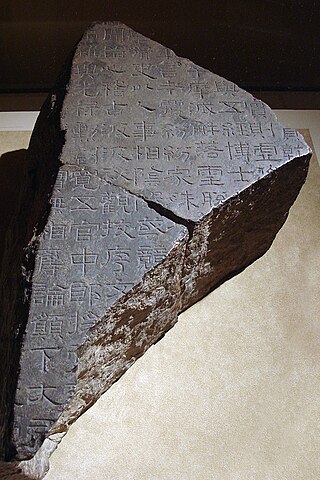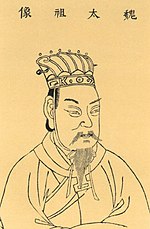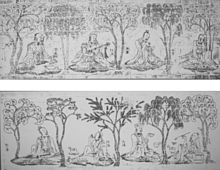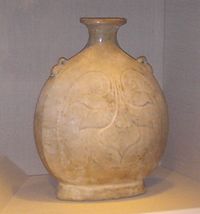
Chinese poetry is poetry written, spoken, or chanted in the Chinese language, and a part of the Chinese literature. While this last term comprises Classical Chinese, Standard Chinese, Mandarin Chinese, Yue Chinese, and other historical and vernacular forms of the language, its poetry generally falls into one of two primary types, Classical Chinese poetry and Modern Chinese poetry.

Qu Yuan was a Chinese poet and aristocrat in the State of Chu during the Warring States period. He is known for his patriotism and contributions to classical poetry and verses, especially through the poems of the Chu Ci anthology : a volume of poems attributed to or considered to be inspired by his verse writing. Together with the Shi Jing, the Chu Ci is one of the two greatest collections of ancient Chinese verse. He is also remembered in connection to the supposed origin of the Dragon Boat Festival.

Shi and shih are romanizations of the character 詩/诗, the Chinese word for all poetry generally and across all languages.
Yuefu are Chinese poems composed in a folk song style. The term originally literally meant "Music Bureau", a reference to the imperial Chinese governmental organization(s) originally charged with collecting or writing the lyrics, later the term yuefu was applied to later literary imitations or adaptations of the Music Bureau's poems. The use of fu in yuefu is different from the other Chinese term fu that refers to a type of poetry or literature: although homonyms in English, the other fu is a rhapsodic poetry/prose form of literature.

The Chu Ci, variously translated as Verses of Chu, Songs of Chu, or Elegies of Chu, is an ancient anthology of Chinese poetry including works traditionally attributed mainly to Qu Yuan and Song Yu from the Warring States period, as well as a large number of works composed during the Han dynasty several centuries later. The traditional version of the Chu Ci contains 17 major sections, anthologized with its current contents by Wang Yi, a 2nd-century AD librarian who served under Emperor Shun of Han. Classical Chinese poetry prior to the Qin dynasty is largely known through the Chu Ci and the Classic of Poetry.

The arts of China have varied throughout its ancient history, divided into periods by the ruling dynasties of China and changing technology, but still containing a high degree of continuity. Different forms of art have been influenced by great philosophers, teachers, religious figures and even political leaders. The arrival of Buddhism and modern Western influence produced especially large changes. Chinese art encompasses fine arts, folk arts and performance arts.

Tang poetry refers to poetry written in or around the time of or in the characteristic style of China's Tang dynasty, and/or follows a certain style, often considered as the Golden Age of Chinese poetry. The Complete Tang Poems includes over 48,900 poems written by over 2,200 authors. During the Tang dynasty, poetry continued to be an important part of social life at all levels of society. Scholars were required to master poetry for the civil service exams, but the art was theoretically available to everyone. This led to a large record of poetry and poets, a partial record of which survives today. The two most famous poets of the period were Li Bai and Du Fu. The Qing dynasty selection, Three Hundred Tang Poems, has made Tang poetry familiar to educated Chinese in modern times.
Jueju, or Chinese quatrain, is a type of jintishi that grew popular among Chinese poets in the Tang dynasty (618–907), although traceable to earlier origins. Jueju poems are always quatrains; or, more specifically, a matched pair of couplets, with each line consisting of five or seven syllables.
Song poetry is poetry typical of the Song dynasty of China, established by the Zhao family in China in 960 and lasted until 1279.

Classical Chinese poetry forms are poetry forms or modes which typify the traditional Chinese poems written in Literary Chinese or Classical Chinese. Classical Chinese poetry has various characteristic forms, some attested to as early as the publication of the Classic of Poetry, dating from a traditionally, and roughly, estimated time of around 10th–7th century BCE. The term "forms" refers to various formal and technical aspects applied to poems: this includes such poetic characteristics as meter, rhythm, and other considerations such as vocabulary and style. These forms and modes are generally, but not invariably, independent of the Classical Chinese poetry genres. Many or most of these were developed by the time of the Tang dynasty, and the use and development of Classical Chinese poetry and genres actively continued up until the May Fourth Movement, and still continues even today in the 21st century.

Classical Chinese poetry genres are those genres which typify the traditional Chinese poems written in Classical Chinese. Some of these genres are attested to as early as the publication of the Classic of Poetry, dating from a traditionally, and roughly, estimated time of around 10th–7th century BCE, in what is now China, but at that time was composed of various independent states. The term "genres" refers to various aspects, such as to topic, theme, and subject matter, what similes or metaphors were considered appropriate or how they would be interpreted, and other considerations such as vocabulary and style. These genres were generally, but not always independent of the Classical Chinese poetry forms. Many or most of these forms and genres were developed by the Tang dynasty, and the use and development of Classical Chinese poetry genres actively continued up until the May Fourth Movement, in 1919, and still continues even today in the 21st century.
The Music Bureau served in the capacity of an organ of various imperial government bureaucracies of China: discontinuously and in various incarnations, the Music Bureau was charged directly, by the emperor, or indirectly, through the royal government to perform various tasks related to music, poetry, entertainment, or religious worship. These tasks included both musical and lyrical research and development, and also directing performances.

Han poetry as a style of poetry resulted in significant poems which are still preserved today, and whose origins are associated with the Han dynasty era of China, 206 BC – 220 AD, including the Wang Mang interregnum. The final years at the end of the Han era often receive special handling for purposes of literary analysis because, among other things, the poetry and culture of this period is less than typical of the Han period, and has important characteristics of its own, or it shares literary aspects with the subsequent Three Kingdoms period. This poetry reflects one of the poetry world's more important flowerings, as well as being a special period in Classical Chinese poetry, particularly in regard to the development of the quasipoetic fu; the activities of the Music Bureau in connection with the collection of popular ballads and the resultant development of what would eventually become known as the yuefu, or as the rhapsodic formal style; and, finally, towards the end of the Han dynasty, the development of a new style of shi poetry, as the later development of the yuehfu into regular, fixed-line length forms makes it difficult to distinguish in form from the shi form of poetic verse, and at what point specific poems are classified as one or the other is somewhat arbitrary. Another important poetic contribution from the Han era is the compilation of the Chuci anthology, which contains some of the oldest and most important poetic verses to be preserved from ancient China, as well as the transmission of the Shijing anthology.

Jian'an poetry or Chien-an poetry, refers to the styles of Chinese poetry particularly associated with the end of the Han dynasty and the beginning of the Six Dynasties era of China. This poetry category is particularly important because, in the case of the Jian'an poetic developments, there is a special difficulty in matching the chronology of changes in poetry with the usual Chinese dynastic chronology based on the political leadership of the times. For example, according to Burton Watson, the first major poet of the new shi style that emerged at this time was Cao Zhi, one of the sons of Cao Cao, a family which came into power at the end of Han and developed further during the Three Kingdoms era of the Six Dynasties period.
Six Dynasties poetry refers to the types or styles of poetry particularly associated with the Six Dynasties era of Chinese history. This poetry reflects one of the poetry world's more important flowerings, as well as being a unique period in Classical Chinese poetry, which, over this time period, developed a poetry with special emphasis on romantic love, gender roles, and human relationships. The Six Dynasties era is sometimes known as the "Age of Fragmentation", because China as a whole through this period lacked unification as a state, at least for any extended period of time; and, instead, many states rose and fell, often overlapping in existence with other states. Which of the various states and dynasties constituted the "6" dynasties of the Six Dynasties period varies somewhat according to which of the traditional selection criteria are chosen. The Six Dynasties era covers several somewhat overlapping main periods including all of the following: the Three Kingdoms (220–280), Jin dynasty, the Sixteen Kingdoms, and the Southern and Northern Dynasties (420–589). Sometimes, chronological discrepancies occur in regard to the turbulent political events of the time, from which these traditional historical-era designations derive, together with the somewhat different chronology of poetic developments. Thus, neither the lives of the poets nor the trends in their poetry fit gently and neatly together with these period dates. Furthermore, conversions to the Common Era dating system can create further complications. However, regardless of the chronological difficulties, major developments of poetry during the Six Dynasties include formalizing the distinction between the Jian'an era regular yuefu and the shi style poetry, further development of the fu, theoretical work on technique, and the preservation of both Six Dynasties and earlier poetry by collecting and publishing many of the pieces which survive today into various anthologies consisting all or in part of poetry.
Yuan poetry refers to those types or styles of poetry particularly associated with the era of the Yuan dynasty (1271–1368), in China. Although the poetic forms of past literature were continued, the Yuan period is particularly known for the development of the poetic aspects included in the complex mix of different art forms which characterize Chinese opera, namely the qu or fixed-tone pattern type of verses that were delivered by the actors of these shows. Although the language of Yuan poetry is still generally considered to be Classical Chinese, a certain vernacular aspect reflecting linguistic changes can be seen in some of the fixed-rhythm verse forms, such as Yuan ci and qu. Certain aspects of Yuan poetry can be understood in the context of the social and political changes which took place as part of the process of the Mongol conquest of the Jin and Song Dynasties and their subsequent establishment of the Yuan dynasty.

Qing poetry refers to the poetry of or typical of the Qing dynasty (1644–1911). Classical Chinese poetry continued to be the major poetic form of the Qing dynasty, during which the debates, trends and widespread literacy of the Ming period began to flourish once again after a transitional period during which the Qing dynasty had established its dominance. Also, popular versions of Classical Chinese poetry were transmitted through Qing dynasty anthologies, such as the collections of Tang poetry known as the Complete Tang Poems and the Three Hundred Tang Poems. The poetry of the Qing dynasty has an ongoing and growing body of scholarly literature associated with its study. Both the poetry of the Ming dynasty and the poetry of the Qing dynasty are studied for poetry associated with Chinese opera, the developmental trends of Classical Chinese poetry and the transition to the more vernacular type of Modern Chinese poetry, as well as poetry by women in Chinese culture.

The History of fu poetry covers the beginnings of the Chinese literary genre of fu. The term fu describes literary works that have certain characteristics. English lacks an equivalent term. Sometimes called "rhapsodies", sometimes "rhyme-prose", fu have qualities of both poetry and prose: both are obligatory. The fu form is a poeric treatment, wherein a topic of interest, such as an exotic object, a profound feeling, or an encyclopedic subject, is described and rhapsodized upon, in exhaustive detail and from various angles. For a piece to be truly considered to be in the fu genre, it must follow the rules of this form, in terms of structure, meter, and so on.

Geese are an important motif in Chinese poetry. Examples of goose imagery have an important place in Chinese poetry ranging from the Shijing and the Chu Ci poets through the poets of Han poetry and later poets of Tang poetry such as Li Bai, Wang Wei, Du Fu, and the Xiaoxiang poetry, especially in the poetry of the Song dynastic era. Various poetic concepts could be communicated by the inclusion of the imagery of geese in a poem, and the understanding of allusions to a goose or geese can help provide key insights into the poems of Classical Chinese poetry. Chinese sources typically distinguish between two types of geese, the domestic goose, and the wild goose: of the two, the wild goose is the more important for poetry, whether as significant of migratory seasonal change, or as "bearing a message of love from afar", by persons separated by a great distance, or as the "lone goose", bereft of both mate and flock.

























